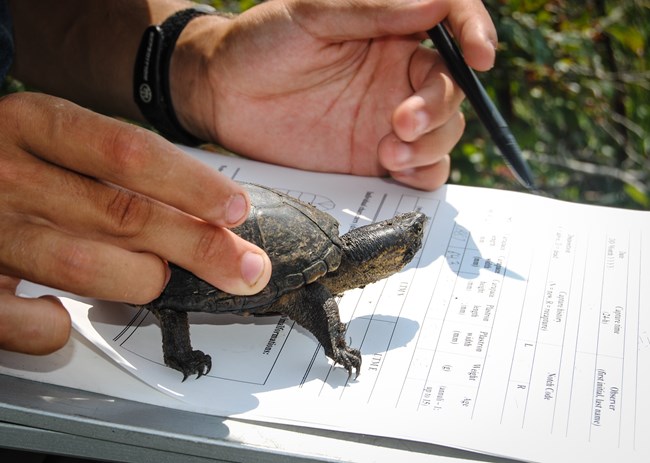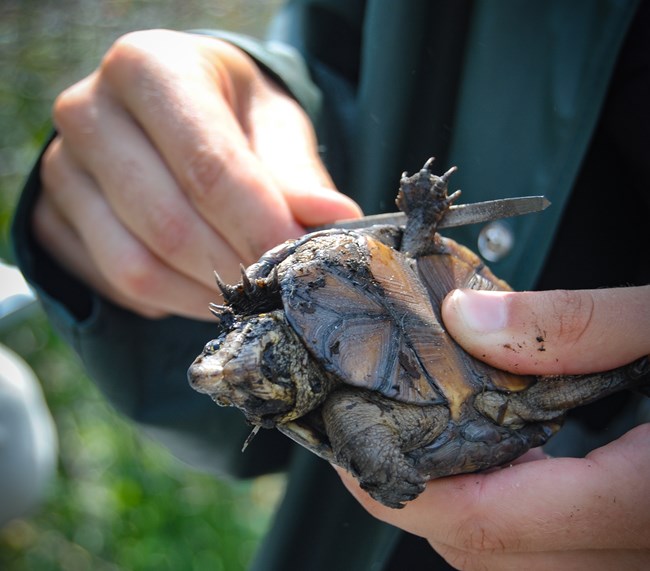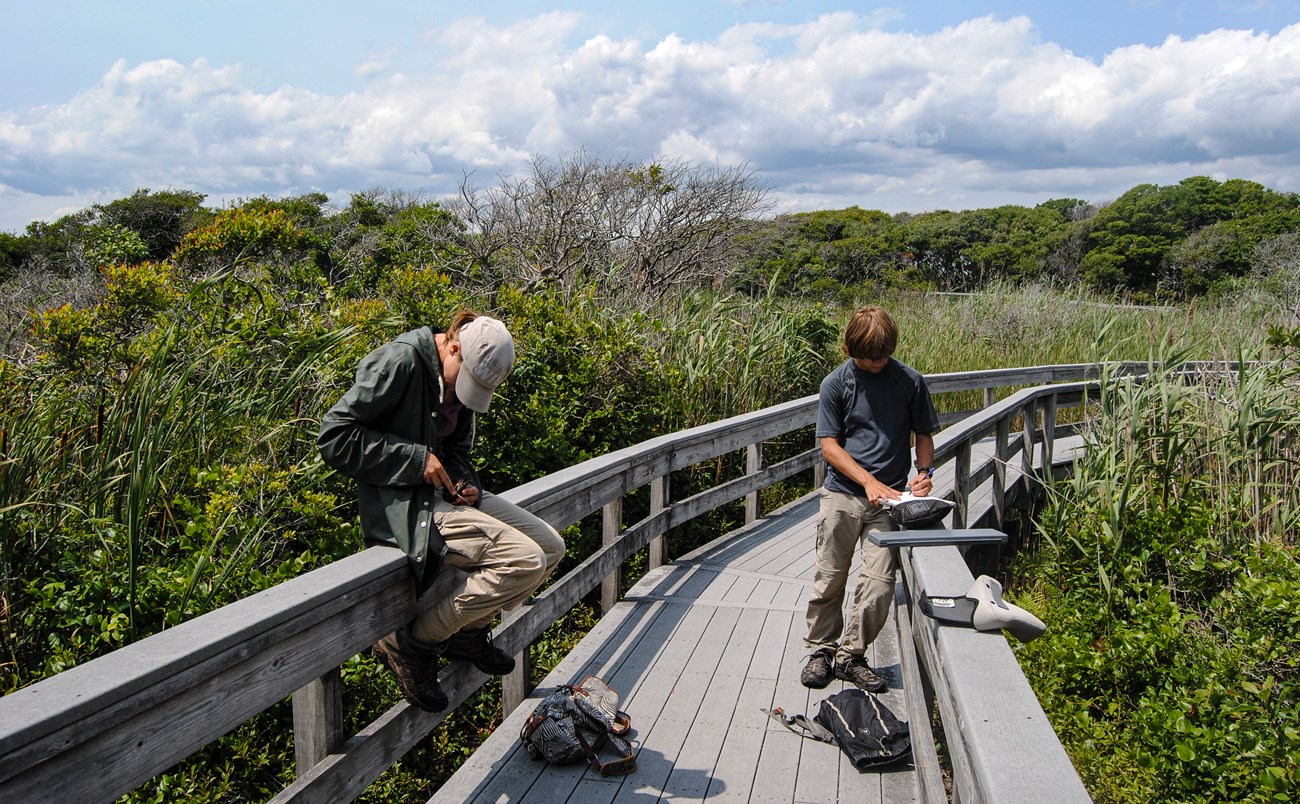Part of a series of articles titled Northeast Coastal and Barrier Network Species Spotlight.
Article
Northeast Coastal and Barrier Network Species Spotlight: Eastern Mud Turtle

Anne Devan-Song
Characteristics and description
Usually meandering its way through the mud (hence the name), the Eastern mud turtle (Kinosternon subrubrum) is a small, aquatic turtle found in shallow wetlands dense with vegetation. They are also known to find a home in salt marshes and brackish ponds near the coastline. The species is widespread across the eastern United States. Their range stretches from the Gulf coast, throughout the southeast, and up the east coast into southern New York state. The Eastern mud turtle is omnivorous and enjoys a smorgasbord of everything from crayfish, mollusks, and insects to leafy greens.
Unlike some of their reptilian counterparts, the Eastern mud turtle is not a flashy creature. Their shells are smooth, dark olive-to-black and oval in shape which makes them quite nondescript. In addition, they are equipped with webbed feet, and adults only measure between 3-4 inches in length. One unique characteristic of the Eastern mud turtle is that the shell is made up of 11 plates—known as marginal scutes—while most species of turtles have 12. This unique characteristic helps researchers identify the species in the wild.
Eastern mud turtles also have the ability to come out of the mud and onto land where they use upland areas for both nesting and hibernation. In areas along the east coast, mud turtles will hibernate from September to May by finding an area to burrow with sandy soil and/or dense ground cover and vegetation. Soon after they wake up in the springtime, mud turtles begin breeding. Females will breed around late April-early May and be ready to lay eggs in a sandy nest by June.

Anna O’Malley
Inventory of amphibians and reptiles
Inventory projects are conducted in Northeast Coastal and Barrier Network (NCBN) parks in order to learn about the location, diversity, and condition of their resources including vascular plants, vertebrates, vegetation communities, air, water, soils, landforms, and climate. They are designed to establish a baseline of information about key natural resources for all NCBN and other Inventory & Monitoring Program parks. Eastern mud turtles can be monitored through inventories of reptiles and amphibians. In particular, inventories of reptiles and amphibians at Fire Island National Seashore (FIIS) provide data about the habitat and whereabouts of mud turtles in New York.

Anna O’Malley
In 2014, a group of biologists from the University of Rhode Island (URI) conducted an inventory of reptiles and amphibians at FIIS. Among their findings was the elusive Eastern mud turtle. Out of 21 wetland total wetlands trapped across the park, only five individual mud turtles were captured. For the group of biologists, it was very exciting to capture such an uncommon turtle in the state of New York. Research projects at FIIS help to better identify species populations at the park. URI student researcher Anna O'Malley recalls “We were always surprised by the number of reptiles and amphibians that we caught in wetlands on Fire Island as many of them were quite ephemeral. I hope that there are more mud turtles hiding in many of the wetlands throughout the island that we did not detect, and that in the future researchers will discover these populations.”

Anna O’Malley
Why Fire Island National Seashore?
Inventory projects are conducted in NCBN parks in order to learn about the location, diversity, and condition of their resources including vascular plants, vertebrates, vegetation communities, air, water, soils, landforms, and climate. They are designed to establish a baseline of information about key natural resources for all NCBN and other Inventory & Monitoring Program parks. Eastern mud turtles can be monitored through surveys of reptiles and amphibians. In particular, surveys at FIIS of reptiles and amphibians provide data about the habitat and whereabouts of mud turtles in New York. Seeing that the species is found in the park and not many other places in the area, FIIS seems to provide just the right habitat for mud turtles at their most northern extent of their range. Data such as this helps park officials how to manage natural resources. For example, knowing where a certain species is located could lead parks to restricting development or access to an area.

Anna O’Malley
How are they doing?
Across their range in the southern United States, the Eastern mud turtle is a common find in muddy waters and the surrounding land. In the wild, they must watch out for predators such as alligators, herons, and especially raccoons who love to feast on a nest of mud turtle eggs. Mud turtles are also susceptible to other environmental stressors such as drought and dry periods. During these times, the Eastern mud turtle is forced to move to land. The turtles of Fire Island have been recorded to only go as far as 600 meters away in search of new places to stay. That doesn’t seem like much to us, but for such a small turtle this is a big feat! While they must watch out for threats in the wild, the most significant threat to the Eastern mud turtle comes at the hands of humans. In New York, Eastern mud turtle numbers are declining due to human development, pollution, and habitat fragmentation. When roads break up and divide their habitat, the turtles are forced to cross busy roadways which puts them in harm’s way from oncoming traffic more often than not. All of these factors have caused the State of New York to consider the Eastern mud turtle an endangered species. FIIS continues to play a major role in preserving lands that support amphibian and reptile diversity, and where species such as the Eastern mud turtle can thrive.
Written by Edward Cascella, Geoscientists-in-the-Parks (GIP) Intern
Last updated: November 27, 2019
